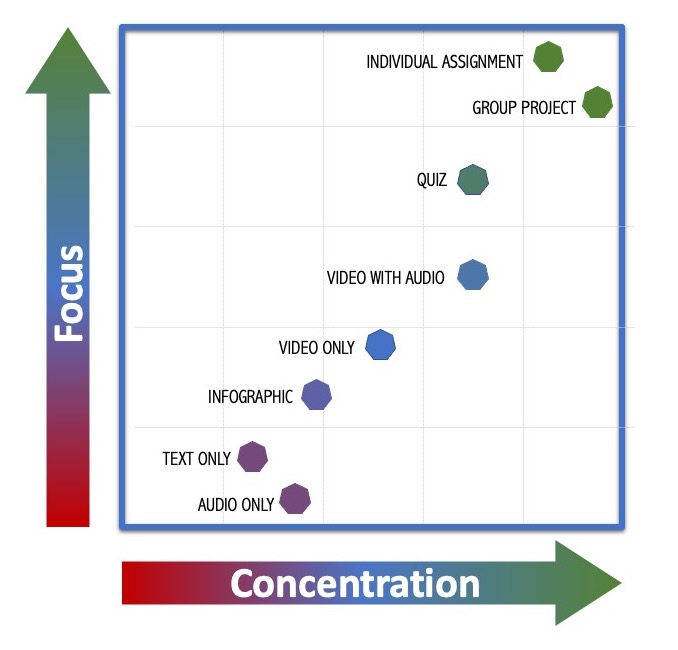
Discover which techniques you should consider when designing your classes and lessons.
There are several definitions around trainee engagement, but at its basic level it simply means trainees are involved – using their senses, focused – paying close attention, concentrating – thinking and considering the information being provided.

When you are creating lessons for your class, how much effort do you put into the information being delivered versus how engaged your trainee will be? No, that is not meant to be a trick question. When a trainee is actively engaged, their retention of the content increases exponentially. This is why understanding and planning trainee engagement will significantly increase your trainee’ ability to get the most from your course.There is some controversy around what constitutes trainee engagement in online learning. Much of this controversy derives from what we can measure.
Knowing if a trainee completes a lesson or course is an easy metric to use
This is why course and lesson completion are the most frequently used measure of trainee engagement. However, completion only guarantees that they are involved. It does not guarantee that they were focused or concentrating. There is a correlation between engaged trainees and course completion, but the reasoning has been misunderstood.
Several organizations have measured course completion against the level of engagement encouraged.

What they discovered was not that trainees who complete the course are learning, but that trainees are more likely to complete a course and learn from it when they are encouraged to actively engage.
 Here is a matrix that shows the average the level of focus and concentration you can expected with the typical lesson format that focuses on the material being delivered rather than trainee engagement.
Here is a matrix that shows the average the level of focus and concentration you can expected with the typical lesson format that focuses on the material being delivered rather than trainee engagement.
If you want to achieve the most involvement, focus, and concentration you will need to apply a combination of techniques that will encourage trainee engagement.
What are some of the techniques you can use to keep your trainees engaged?
Calls to Action
Psychologists and marketing agencies know that the secret to achieving any goal is to take action on them. This is why advertising campaigns have calls to action, breaking habits have steps, and motivational speakers have you create lists. You can use this these techniques to help your trainees take action while attending your class. These can be actives that your trainee can do alone or with someone else.
Here are few sample calls to action others have used:
Make a Promise
- Upfront Commitment
- Affirmation
- Tell a Friend
Have a Conversation
- Message in a Class Forums
- Post on Social Media
- Meet with a Peer
- Write in a Journal
Reciprocal Teaching
- Predicting What’s Next
- Questioning Common Misconceptions
- Identifying Confusing Concepts or Industry Jargon
- Suggesting Additional Information or Material
Edutainment
Edutainment was a term introduced in the 1950s by Walt Disney. It is used to describe content that is mostly intended to teach but also has the value of being entertaining. Concentration wanes when trainees become bored. One of the ways you can offset the dry nature of a lesson is to add a little enjoyment.
- Add Humor
- Funny Phrases
- Light Jokes (Be funny, not a comedian)
- Cartoons, Images, Memes
- Story Telling
- Tale or Chronicle
- Storyline Transitions
- Cliff Hangers and Suspense
- Surprise
- Shocking revelation
- Unbelievable statistics
- Crazy Anecdotes
Gamification
Gamification in education is a way of increasing trainee engagement by incorporating elements used in game design. IBM discovered that online course completion increased by double digits after badges were introduced with their Digital Badge Program. Taking lessons and studying are terms that make people think of hard work. Think about it, continuing your learning outside of the class is not called home-learning it is called homework. Games and play are terms that make people think of joy. If you can incorporate elements from game design, it will not only help your trainees engage it will make taking your course fun rather than a chore.
- Adventure
- A Quest
- A Trail To Follow
- Scavenger Hunt
- Something to Solve
- Puzzles
- Problems
- Riddles
- Goals
- Badging
- Achievements
- Progress Bar
Community & Collaboration
After many colleges were forced to pivot to remote learning, To Hat surveyed about 3,000 trainees. I was surprised to learn that two-thirds of the trainees surveyed said they missed interaction with their professors and peers. One of the greatest tools for engaging trainees is to create opportunities for conversations and connections.
- Study Sessions
- Group Coaching Calls
- Video Conference Tutoring
- Open Forum for Questions
- Places to Chat
- Group Messengers such as Slack or Teams
- Course Hashtags for Social Media
- Group Assignments
- Breakout Sessions
- Collaborative Deliverables – Shared documents
- Individual contribution to a Group Project or Collection
Anytime, Anywhere Learning
In today’s always connected work, we need to make it easy for our trainees to learn from anywhere and at any time. If your trainee is only able to go through the lessons when they are on wi-fi on a desktop or laptop. This significantly limits the time your trainee has to devote to this class. You need to ensure that your course goes where they go and is easy use on any device.
- Make It Mobile Friendly
- Videos and Slides have larger fonts and less text
- Lessons work well in portrait or landscape
- Take It With Them
- Downloadable content
- File sizes are optimized for low bandwidth
- Take Under Not Ideal Situations
- Audio has captioning
- Colors have contrast
- Lessons are Bite-Sized
Organizations have discovered that micro or bite-sized courses increase lesson and course completion by 75%
Transformation
trainees will remain engaged if they can see a value in taking the time to complete your course. Successful teachers and course creators know that people do not take courses because they want to be a trainee. They purchase or enroll in a course because they want to achieve a specific result. Design your course to ensure you can show transformation and achievement.
- Increases Hiring Value
- Certifications
- New Skills
- Adds To Their Credibility
- Increase in Proficiency
- Addition To Their Portfolio
- Achievement (something to brag about)
Real World Application
One of the items frequently found in a courses review is that the trainee wished there was more on how to apply the lesson to the real world. You can tell them that your course materials will help them but showing them will get more of their attention. Also, material can be easier to understand when it relates to real-life situations.
- Examples
- Case Studies
- Scenarios
- Analogies
- Try It For Yourself
- Real World Projects
- What Would You Do If…?
- What Could They Should Done (Scenario that went badly)?
The next time you are designing lessons for your class remember to define not only what they will learn but also how they can actively engage as well.